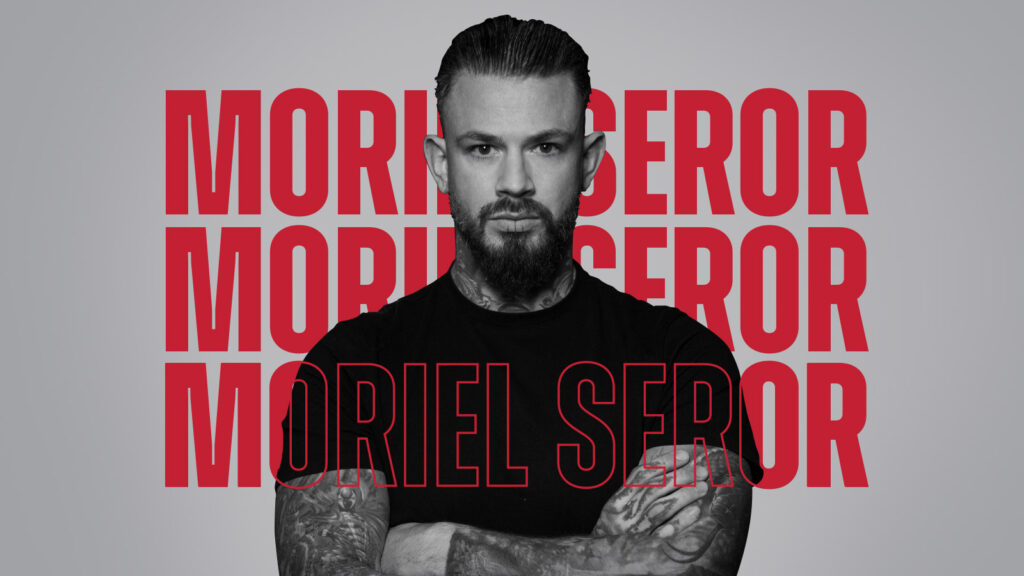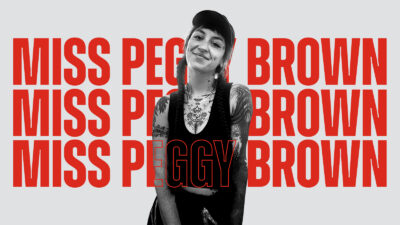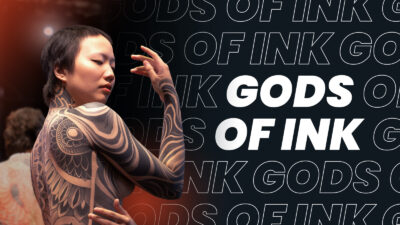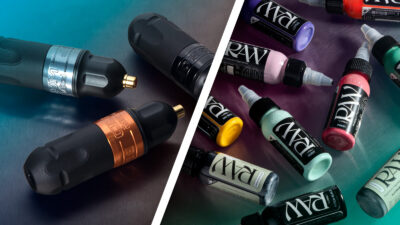Sponsored Artist of the Month – Moriel Seror
We had the pleasure of learning more about Moriel Seror, an incredible tattoo artist and entrepreneur, based at Mori Occultum in Munich!
Read our conversation with him and learn how he got into tattooing, his favourite horror tattoo he has designed, and how he has recently started to define his style as surrealism because it allows for more creativity and expression!
Can you tell us about your journey in the tattoo industry from getting your first tattoo to becoming a tattoo artist? What initially drew you to the world of tattoos?
I got my first tattoo at 16 as a birthday gift from my stepdad. I had to choose between a tattoo and a cellphone, but at the time, he believed cellphones were hazardous, so I went with the tattoo.
My journey into the tattoo world started early, but it took several more years and different paths before I became a tattoo artist. Growing up, we struggled financially. My mother, a single mom of three and an artist herself, faced challenges making a living. So, as a child, I aspired to become a successful manager, maybe in finance or a similar field.
I ended up studying computer science and worked as a graphic designer and web developer for a while, all the while expanding my tattoo collection. But despite my intentions, I still felt drawn to life as an artist.
On one of my visits to my tattoo artist, I asked if I could apprentice under him. He agreed on the condition that I practice for a year and, if I proved to be good enough, I could work in his studio.
What was the most challenging aspect of your apprenticeship with Yancoo Tattoo, and how did you overcome it?
Being an apprentice is always challenging, and it was even tougher back then. The tone was harsher, and the technical skills needed, especially in handling tattoo machines, were at a higher level.
There wasn’t much information available online—just a few poorly made YouTube videos and some DVDs. The key to overcoming these challenges was consistency. You have to keep working through every obstacle and remember that mistakes are inevitable. But that's how we learn; it's wired into us.
In those early years, I worked nonstop and never said no to any style, which really helped me hone my technical skills.
You’ve talked a lot about perfection. How do you balance striving for perfection, having fun with designs, and dealing with the fact that perfection is impossible as an artist?
Perfection doesn’t exist, and it’s the enemy of productivity. Striving for greatness is much more effective.
For a long time, I believed that if you were content with your abilities, you would stop growing. But the truth is, the key is to be happy with what you have while never being fully satisfied. This way, you stay happy but also continue developing.
Constantly pushing for perfection will only lead to misery because it’s unattainable. I think it’s better to approach everything playfully. If you can gamify your work, you’ll never feel like you’re working a day in your life.
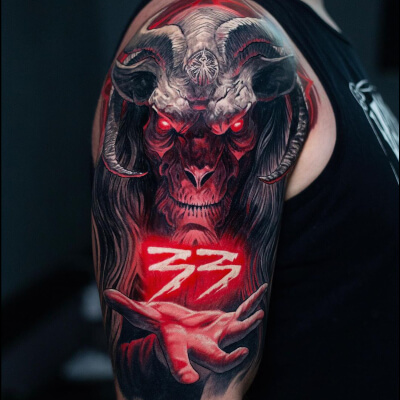
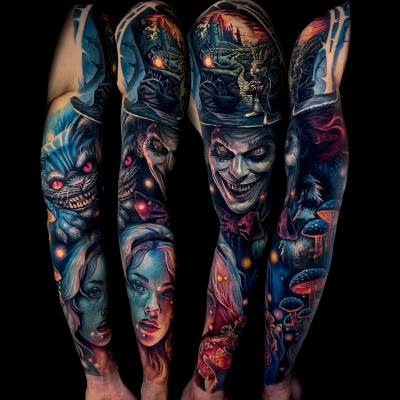
How would you describe your tattooing style, and how do you ensure each piece reflects your clients' individuality as well as your own?
For a long time, I struggled to define my style, but in recent years, I’d say I’ve leaned more toward surrealism. I don’t do traditional realism anymore because I find that surrealism allows me to express myself more fully and create truly unique pieces for my clients. They give me complete creative freedom, which enables me to deliver the best possible results.
Empathy plays a big role in understanding my clients’ needs. If you listen well and demonstrate your expertise, clients tend to trust you more, which allows for more creative freedom.
Large-scale tattoos can be stressful for clients because they’re unsure if the result will meet their expectations. If you, as the artist, seem insecure during consultations, they will feel the same and may try to take control of the artistic process. Showing professionalism helps build their confidence in you as an artist.
Collaboration seems to be a big part of your journey. What was the most memorable collaboration you’ve been a part of, and how did it impact your work?
Probably my first big collaboration—the clown backpiece we did in two days. I worked with Adrian Cier, Torsten, and Kätlin Malm on that project. The energy was incredible, we laughed a lot, and it felt like a great creative flow. That piece went viral, and major news agencies even approached us to feature it.
Collaborations like this are great for improving both your artistic and communication skills. Working alongside artists you admire pushes you to elevate your own work and become more open to constructive criticism.
Is there anyone you’re yet to collaborate with that you want to?
That’s a tough question because I’d love to collaborate with most of the artists I follow. But I think the most exciting challenge would be to work with an artist whose style is very different from mine. Combining two opposing styles could lead to some interesting results and would definitely be a great creative challenge.
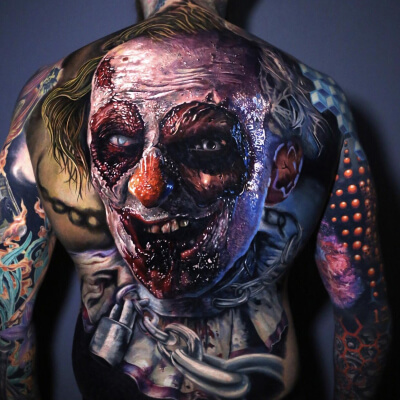
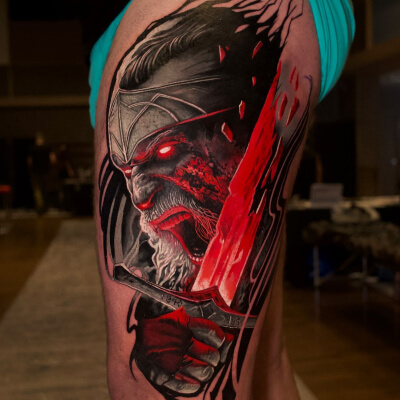
How does the energy and creativity within your studio influence your work and collaborations with other artists?
The energy in a workspace is crucial for happiness and productivity. If the energy is off, it’s hard to relax and be creative. When we bring in new artists, we make sure the team dynamic is right. That’s why we have test periods for new artists. It’s not about anyone being a bad person—it’s just about finding the right energy. Most of the time, your gut instinct is right; you just have to learn how to listen to it.
Can you talk us through your workstation? What machines, needles, inks, and power supplies do you use, and why do you prefer them?
I use Cheyenne tattoo machines and needles exclusively. Depending on the project, I switch between the Sol Nova Unlimited 4.0 or 3.5—4.0 for colour and 3.5 for black and grey. My magnum needles are always curved and 0.35, but for black and grey work, I sometimes use thinner needles.
I use Intenze inks because they’ve proven to give the best long-term results. For healing, I trust Tattooarmour—it’s the best solution for large-scale tattoos. It absorbs all the excess fluids, keeping the client perfectly protected and minimising the risk of mistakes during the healing process.
Mori Occultum is described as a haven for creativity. How do you cultivate such an atmosphere in your studio?
At Mori Occultum, every artist has the freedom to be themselves and work in their own way. Creativity thrives when your mind is free, and that’s something we prioritise.
We also encourage a high level of artistic exchange between our artists, allowing everyone to grow together. When people feel supported and have room to express themselves, creativity naturally flourishes.
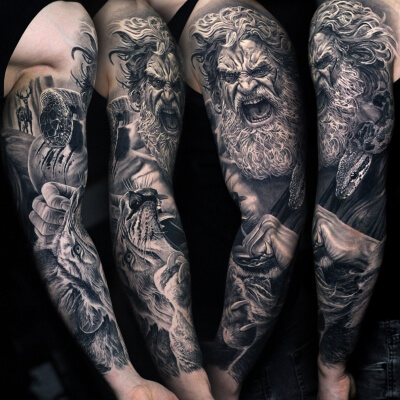
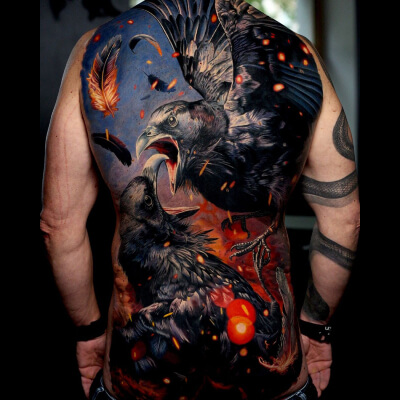
What role do guest artists play in your studio, and what are your plans for bringing in more guest artists in the future?
Given the current economic situation, it’s not always easy to host guest artists, especially those who don’t have a local client base in Munich. However, we’re always open to welcoming artists who want to visit.
When we do have guest artists, we strive to provide a professional and welcoming environment from the very first point of contact. We want them to feel comfortable and appreciated, which is key to fostering a good working relationship.
You’ve participated in many conventions. Which ones have been your favourite? How have these experiences influenced your work and your approach to tattooing?
It’s hard to pinpoint just one favourite convention because there have been so many great experiences.
Convention life can be tough— the travelling is exhausting, but the growth that comes from it is unparalleled. The thrill you get during conventions pushes you to work harder than you ever could in your studio. The determination, along with the conversations you have with other artists, propels you to levels you didn’t think you could reach.
I’ve made some of my closest friends at conventions, and the connections you build are invaluable.
What has been your favourite horror tattoo that you've worked on, and what made it stand out to you?
It’s definitely the horror clown backpiece that I mentioned earlier. The creation process was a lot of fun, and the result really speaks for itself. The collaboration, energy, and final outcome all made it a standout project for me.
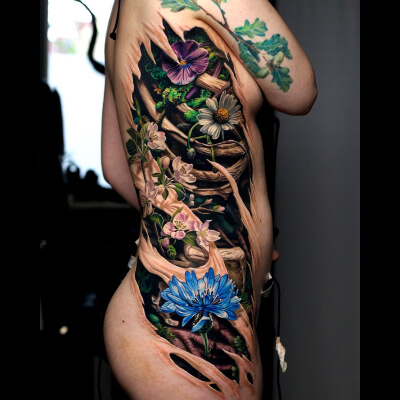
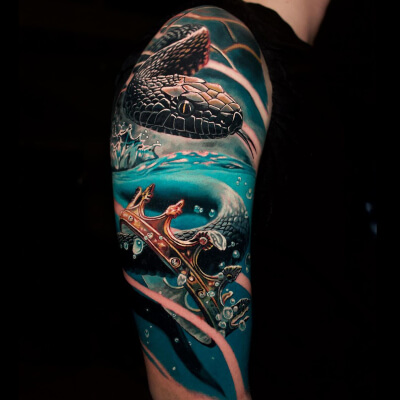
Where do you draw inspiration from when creating new designs, and how do you keep your creativity fresh?
I believe inspiration isn’t something you seek—it’s something you receive when your mind is open to the world around you. If you stay open while exploring, inspiration will naturally come from various sources.
Sometimes it’s a client, sometimes it’s a random encounter, like seeing how light hits someone’s skin, and other times it’s other artists who inspire me. Engaging in artistic exchanges and being open to criticism helps prevent getting stuck in a rut.
If you’re experiencing a creative block, discussing your designs with colleagues or people you admire can help get the creative juices flowing.
Aside from tattooing, what else do you spend your time doing?
Most of my time is spent between my computer, my family, and working out. Being both a tattoo artist and an entrepreneur is time-consuming but also very rewarding.
I enjoy the contrast between these two aspects of my workdays, and it helps me understand the needs of the industry from both sides—supplier and artist.
My family is my sanctuary, where I recharge my batteries. Working out is also a crucial part of my life. Staying physically and mentally fit is essential for performing at my best in both tattooing and business. It’s the one time of day when my mind quiets down.
What advice would you give to artists just starting out in the industry?
Be consistent, stay open to criticism, and have passion. These three principles are key to success.
Consistency will see you through, even when others or you yourself have doubts. Seeking out constructive criticism and truly listening to it will help you improve much faster.
Lastly, passion is what keeps you motivated. If you love what you do, it won’t feel like work, and that enthusiasm will drive you forward.
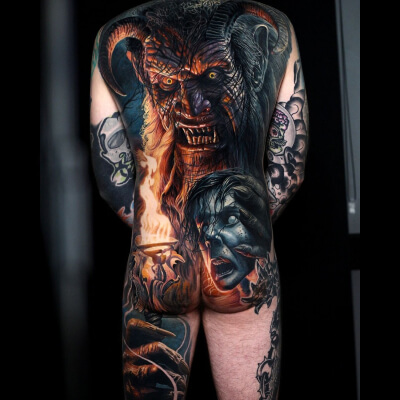
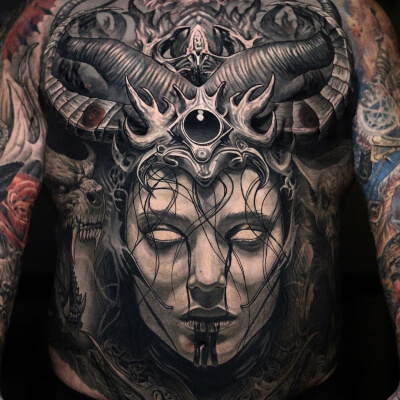
What has been the biggest lesson you've learned throughout your career as a tattoo artist?
The biggest lesson I’ve learned is not to let others determine your worth. Strive for greatness, but don’t lose yourself along the way.
Treat everyone with kindness because you never know what they might be going through. Give without expecting anything in return, and you’ll find that you receive far more in the end.
Can you tell us about the Seminars with We Make Artists and what that will involve?
WeMakeArtists is a platform for artists at all levels, offering high-quality seminars led by some of the greatest artists in the world. The production quality and presentation are flawless.
I’ve personally watched many of these seminars because there’s always something new to learn. The artists share their "secrets" to success and provide real-time demonstrations of how to apply those tips.
If anyone is interested, they can use my promo code “mori” for a discount.
What are your goals for the future of Mori Occultum, both as a studio and a creative space?
We want to grow the Mori Occultum brand and establish the studio as a benchmark for quality work and professionalism at the highest level.
Every year, we hold a charity walk-in day where all proceeds go to charity, but I’m planning something even bigger—a charity convention. I’m still in the planning stages, but I’m excited to see where this idea will go.
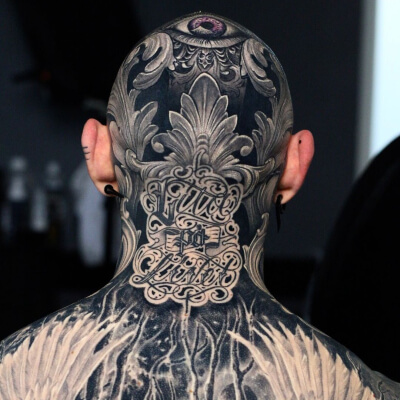
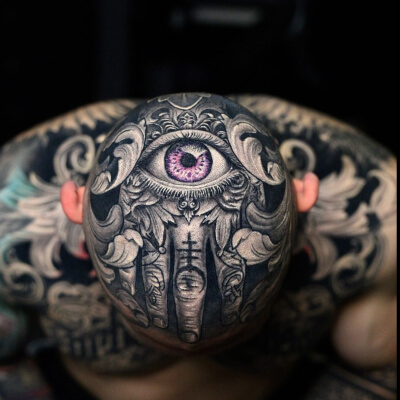
What upcoming conventions or projects are you most excited about, and why?
I’m really excited for the Paris convention in January, as well as the charity convention I mentioned earlier.
Both events are great opportunities to connect with other artists and contribute to something bigger.
Where do you see your tattooing career evolving in the next few years, and what new challenges or opportunities are you looking forward to?
With the rise of AI, it’s hard to predict the future of any industry, but I believe that human creativity will continue to evolve. Even in an age of computerisation and automation, people will always find ways to express themselves.
Personally, I aim to continue developing as an artist, entrepreneur, and individual. One of my goals is to make Tattooarmour the industry standard for tattoo aftercare.
A big thanks to Moriel for taking the time to answer our questions, it was a pleasure to get to know more about the man behind the art! Make sure to check out his work on Instagram at Moriel.Seror or visit Mori Occultum yourself!
You May Also Like
-
April 21, 2025
More Than Words - Best Tattoo Lettering
In this blog you’ll find a huge range of tattoo script styles, from delicate handwriting to big, bold statements, in both simple and complex ways.Read More -
April 7, 2025
Sponsored Artist of the Month – Miss Peggy Brown
Miss Peggy Brown is Bristol’s premiere magic realism tattoo artist, creating hand-drawn ornamental motifs and imaginary flowers that flow around the body.Read More -
March 31, 2025
Strokes of Genius - Best Watercolour Tattoos
In our latest collection of tattoos by our talented sponsored artists, we take a look at the fine art of watercolour tattoos!Read More
Latest
-
April 21, 2025
More Than Words - Best Tattoo Lettering
In this blog you’ll find a huge range of tattoo script styles, from delicate handwriting to big, bold statements, in both simple and complex ways.Read More -
April 17, 2025
Gods of Ink Tattoo Convention 2025 Video
The Gods of Ink convention in Frankfurt, hosted by industry legend Miki Vialetto, is always a huge highlight of our year!Read More -
April 14, 2025
Tattoo Trends 2025
From tattoo inks to machines and aftercare, here are the hottest tattoo trends for 2025 to help you stay ahead of the game!Read More
